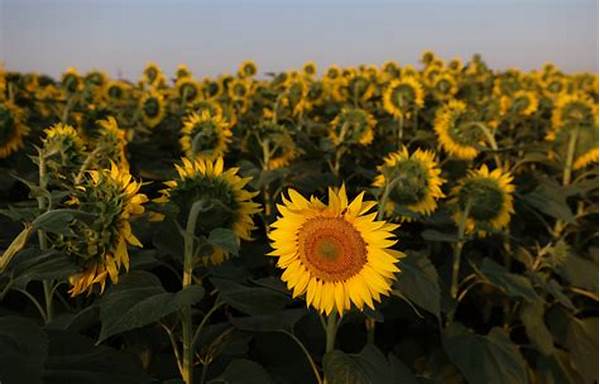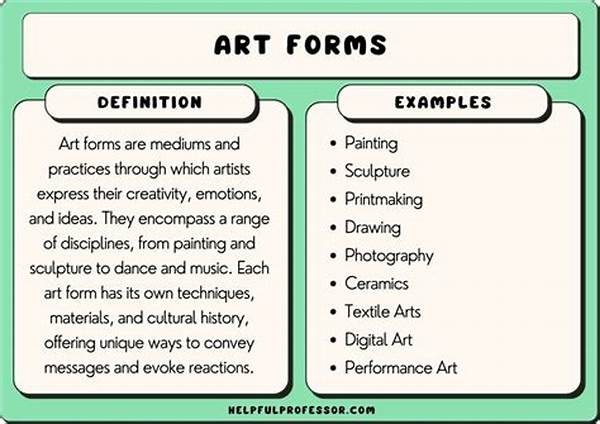Hey there, art lovers! Ever felt like some pieces of art just grab your attention and make you stop in your tracks? Yup, those masterpieces know a thing or two about creating focal points in art. Whether you’re an artist looking to captivate your audience or just someone curious about how art ticks, understanding focal points can be quite an eye-opener. Let’s dive into how these magic points work and why they’re so crucial to art.
Read Now : Unique Pet Portrait Ideas
The Importance of Focal Points in Art
So, why all the fuss about creating focal points in art? Well, focal points are like the highlight reel of an artwork. They draw the viewer’s eye to the most important part, making sure nothing significant goes unnoticed. Think of it as the spotlight on a stage—it guides the audience to where they should be focusing. Without these focal points, artworks may seem scattered or confusing, lacking a coherent flow. Creating focal points in art involves using various elements like color contrasts, lines, and shapes to ensure the viewer’s gaze is directed exactly where the artist wants. This technique not only brings clarity but also adds an emotional depth and storytelling element to the piece. It’s like guiding someone through a story, showing them exactly where the climax lies. Whether you’re into painting, sculpture, or any other form of art, mastering the art of creating focal points can truly elevate your work from ordinary to extraordinary. So next time you’re lost in an artwork, take a moment to pinpoint where your eyes land first—that’s the focal point working its magic!
Techniques for Creating Focal Points in Art
1. Color Contrast: Using contrasting colors can instantly draw attention to a specific area. It’s one simple yet effective method of creating focal points in art.
2. Lighting and Shadows: Playing with light and shadows can direct the viewer’s attention to the focal point, creating a sense of depth and intrigue.
3. Lines and Shapes: Incorporating lines and shapes can lead the viewer’s eye towards the focal area. Think of them as a map guiding the journey.
4. Texture Variations: Different textures can make elements stand out, helping in creating focal points in art. They add dimension and interest too!
5. Scale and Proportion: Making one element larger can emphasize its importance, effectively creating focal points in art and leading the viewers through the artwork with ease.
Visual Hierarchies in Art
Wondering how to set up a visual hierarchy when creating focal points in art? It’s all about prioritizing elements. Visual hierarchy involves using size, contrast, and color to establish the importance of different elements within a piece. For instance, a larger object in a painting might serve as a primary focal point, catching the viewer’s eye first. Creating focal points in art with visual hierarchy ensures that the viewer processes the artwork in an intended sequence. This hierarchical attention to detail helps communicate the message or emotion in the artwork more effectively. By thoughtfully arranging visual elements, you transform a flat canvas into a vibrant narrative. Next time you’re gazing at an artwork, try deciphering its visual hierarchy—it’s like unlocking a treasure map of artistic intent. Whether it’s a bold splash of red in a sea of blues or a luminous figure amidst shadowy surroundings, each choice is a deliberate act of creating focal points in art.
Practical Tips for Creating Focal Points
1. Use Bold Elements: Bright colors or dark shadows are great for creating focal points. They stand out and attract attention immediately.
2. Positioning is Key: Centering an element or placing it at the “Rule of Thirds” intersection can make it a natural focal point.
3. Add Intricacy: Textured or detailed elements tend to be eye-catching. This can be helpful in creating focal points in art.
4. Limit Distractions: Minimalist backgrounds ensure the focal point shines. Simplicity can often enhance the focus.
Read Now : Ai-powered Photo Retouching App
5. Use Movement: Suggest motion towards or around the focal area, drawing the viewer’s attention there.
6. Incorporate Repetition: Repeating patterns can guide the gaze to the focal point.
7. Consider Framing: Using frames or borders can isolate and highlight the focal point.
8. Strategic Lighting: Spotlighting or using natural light can accentuate the focal point.
9. Create Contrast: This could be in tone, color, or texture. It highlights the focal point effectively.
10. Vary Proportions: Make the focal point larger or in unusual proportions to stand out.
Understanding Depth and Focal Points
Creating focal points in art often involves an intricate play with depth. Depth can add layers to your artwork, making the focal point distinct yet integrated. Imagine a painting where the background softly fades away as the foreground elements come alive. That’s depth at work! By manipulating focus, clarity, and the overlapping of elements, an artist can ensure that the intended focal area stands out. This not only enriches the visual experience but also guides the viewer’s emotional response. When creating depth, it’s like inviting the viewer into a different world, with the focal point as the main attraction. Mastering this will make your art not only eye-catching but also soul-stirring. Whether it’s a serene landscape or a bustling abstract piece, how an artist manipulates depth can significantly influence the outcome of creating focal points in art. It engages the viewer, letting them delve deeper into the storyline being unraveled on the canvas. So remember, next time you’re either crafting or admiring art, look for those layers—they’re the breadcrumbs leading you to the masterpiece’s focal point!
Creating Focal Points in Art Through Design
Okay, real talk! If you’re just getting started with art and design, creating focal points in art can sound kind of intimidating. But guess what? It doesn’t have to be. By understanding a few basics and playing around with elements, you’ll be creating epic focal points in no time. Think of yourself as a director setting the scene—lighting, positioning, and making sure all eyes are exactly where you want them. It’s as simple as experimenting with contrast, texture, and alignment, tweaking each until your artwork pops. Sometimes, it’s about going wild and breaking the rules; other times, it’s about restraint and letting simplicity do the talking. Whether you’re crafting a digital graphic or sketching on paper, remember that practice makes perfect. The more you try different techniques, the more second nature creating these focal points in art will become. So grab those brushes, fire up that software, and let your creative instincts lead the way!
Summarizing Focal Points in Art
Alright, so let’s wrap things up! Creating focal points in art isn’t just a neat trick; it’s the secret sauce that gives artwork its mojo. By using elements like color, contrast, and composition wisely, artists can transform ordinary pieces into mesmerizing masterpieces that demand attention. It’s all about guiding the viewer through a visual narrative, showcasing what’s vital, and subtly whispering the hidden tales behind each brushstroke. Remember, each focal point holds the power to engage, evoke emotions, and leave an indelible mark on the viewer’s mind. Whether through controlled chaos or elegant simplicity, understanding how to create these points will elevate your artistic journey. So next time you lose yourself in a painting, remember to pause and appreciate the focal magic at play—it’s where the heart of the artwork truly lies. Dive in, create, and watch your art come alive with vibrant focal points leading the way. Happy creating!



